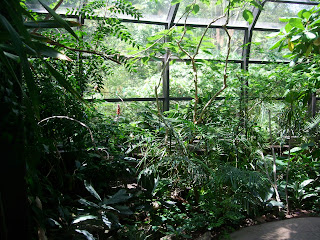Thursday, June 2, 2011
Courtship: Nature Center 5/29/11
Turtles court each other when the male massages the female with its fore claws, and female turtles usually pick a male with nice long fingernails.
Thigmotropism: Porter Creek 5/26/11
The ivy in this picture is growing up the tree truck because of thigmotropism. Thigmotropism occurs when an organism grows in response to touch or stimuli. In this case, the tree provides that stimuli, causing the ivy to grow on it.
3 Levels of Biodiversity: Zoo 5/20/11
This is a picture from the rain forest at the zoo. The rain forest is the most diverse environment found on earth. The three levels of biodiversity include genetic, species, and ecosystem. In this picture many different plant species are represented, and their genes are different as well. An ecosystem in the rain forest is much different than that of the tundra, or a desert.
Cryptic Coloration: Nature Center 5/29/11
Cryptic coloration is a type of camouflage. These stick bugs are the same color as the stems of plants in their environment. This helps them blend into their environment and hide from prey.
Water Cycle Components: Zoo 5/20/11
The water cycle consists of many different processes including evaporation and transpiration, condensation, precipitation, and collection. This is a picture of water evaporation; the water is turning into vapor and being released into the atmosphere. Condensation then occurs in the clouds where the water vapor turns back into a liquid. The water in a liquid form then will precipitate and fall back to the ground. Collection is when the water gathers together on the ground in oceans and lakes and can result from runoff.
Tertiary Consumer: Nature Center 5/29/11
This hawk is a tertiary consumer because it eats secondary consumers. Hawks can eat snakes which are secondary consumers.
Secondary Consumer: Nature Center 5/29/11
Secondary consumers eat primary consumers. This snake's diet consists of small rodents, which are primary consumers because they are herbivores.
Producer: Porter Creek 5/26/11
Producers are able to make their own food and serve as an energy source for other organisms. This plant produces sugar by carrying out photosynthesis and serves as a meal for other organisms.
Perennial Plant/ Phototrophism: Backyard 5/30/11
Perennial plants live for more than two years. These plants are dormant throughout the winter, then they grow back in the spring to continue out their life cycle. When plants grow toward the light source, it is called phototrophism. These plants are leaning out from under the roof of the house to grow toward the light.
Shoot Apical: Backyard 5/30/11
A shoot apical is where new growth takes place in plants. For example, in this picture, new leaves are shown sprouting out from the stem.
Analogous Structures: Zoo 5/20/11 & Backyard 5/30/11
Analogous structures are structured differently, but that have the same function. Bird wings and bee wings differ in structure, but they both serve the same purpose, helping the organisms fly.
Homologous Structures/ Altruistic Behavior: Zoo 5/20/11
Homologous structures are similar structures with different functions derived from evolution. The rhino and the koala's forelimbs have the same basic structure but serve different purposes. The koala uses its arms to grasp tree branches and hold its young while the rhino uses its forelimbs for walking and running. The mom koala in the photo above shows altruistic behavior, because she is going out of her way to care for her young. She feels it is her duty to take care of her young and be selfless when doing so.
Science as a Process: Zoo 5/20/11
The zoo portrays the idea of science being a process. It is the responsibility of the vets, zookeepers, and other staff to create and maintain a habitat that replicates the natural habitat of the animals, making them feel more at home.
Wednesday, June 1, 2011
Aggregate Fruit/ Seed Dispersed by Animals : House 5/30/11
Aggregate fruits develop from many separate carpels of one flower. Strawberry seeds are dispersed by animals because when they are consumed, its seeds are deposited elsewhere.
Plant w/ Fibrous Root System/ Gravitrophism: Backyard 5/30/11
A fibrous root system is a mat of thin roots spredding out below the surface of the ground. The stems of this plant grow in an upward direction, while the roots grow in a downward direction, due to gravitrophism.
Example of Xylem Tissue/ Example of Phloem Tissue: Backyard 5/30/11
Xylem tissue moves water up a plant from roots to shoots while phloem transports nutrients throughout the plant in both directions.
Tuber: House 5/30/11
Potatoes are tubers because they are enlarged ends of rhizomes and are specialized for storing nutrients.
Example from the Class Actinopterygii: Nature Center 5/29/11
This fish is a member of the class Actinopterygii. The class contains ray-finned fishes that have fins that are long and flexable and are used for maneuverability and defense.
Eukaryote/ Cellular Respiration: Nature Center 5/29/11
This deer would be described as a eukaryote. Its cells have membrane enclosed organelles and its cells are differenciated in order to perform the variety of functions needed to survive. It's cells are always undergoing cellular respiration. They break down the food consumed by the deer to make useable energy.
Carbohydrate/ Lipid/ Protein: Nature Center 5/29/11
This fox's fat is made up of lipids. It's muscles rely on protein in order to keep them strong and durable. It consumes carbohydrates for useable energy.
Subscribe to:
Posts (Atom)



























